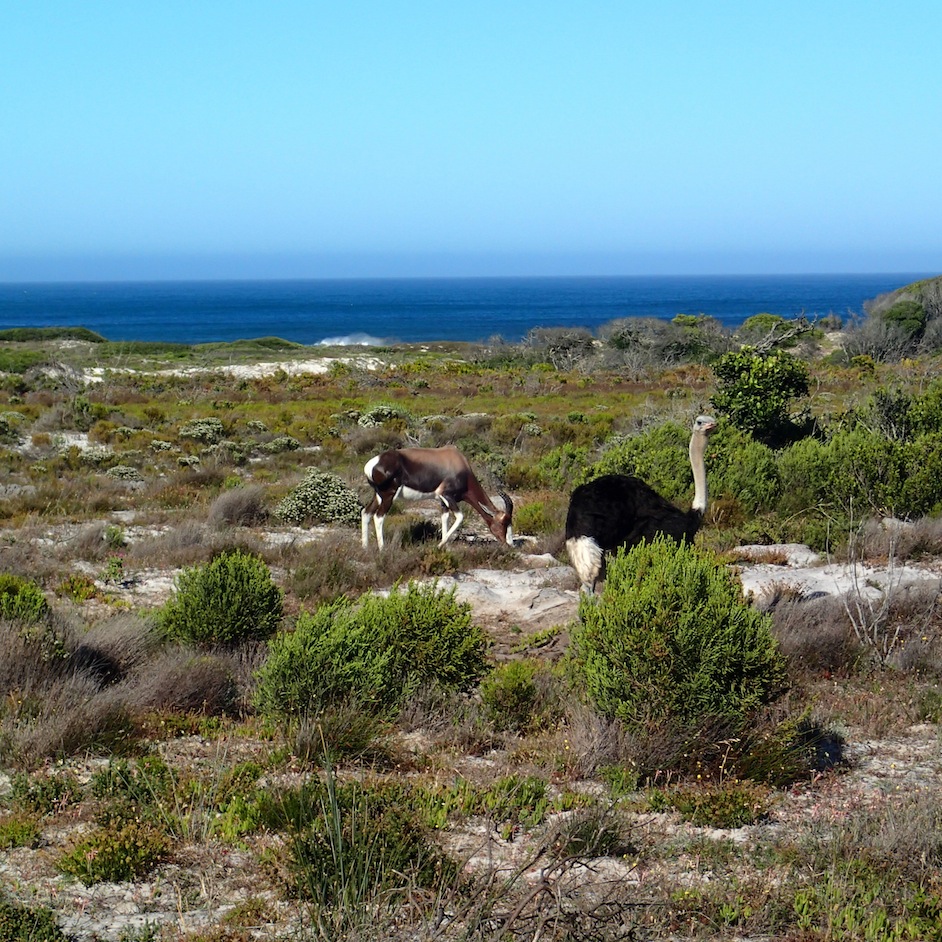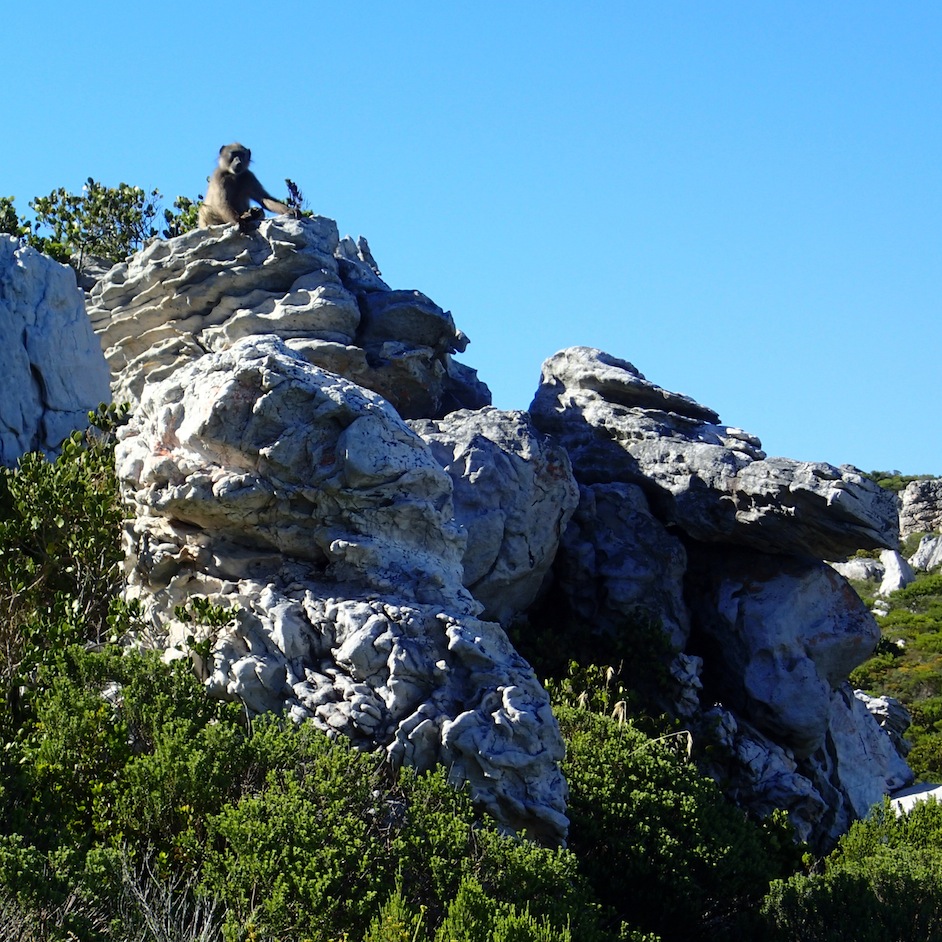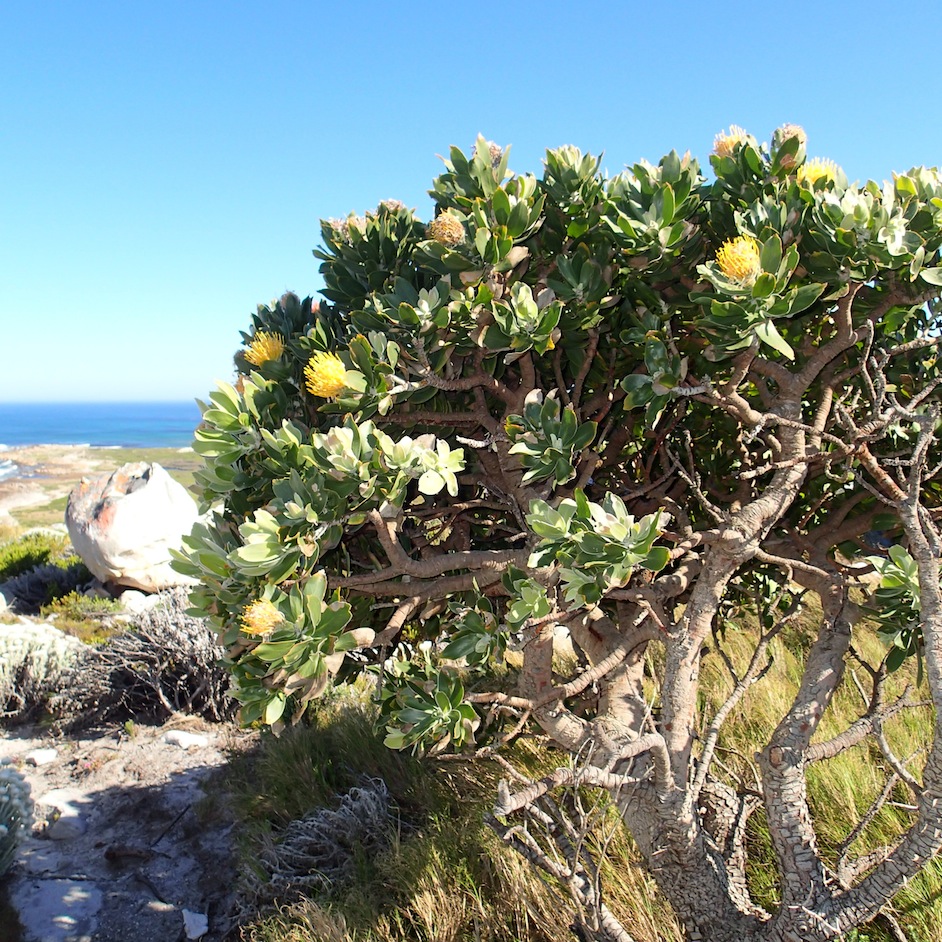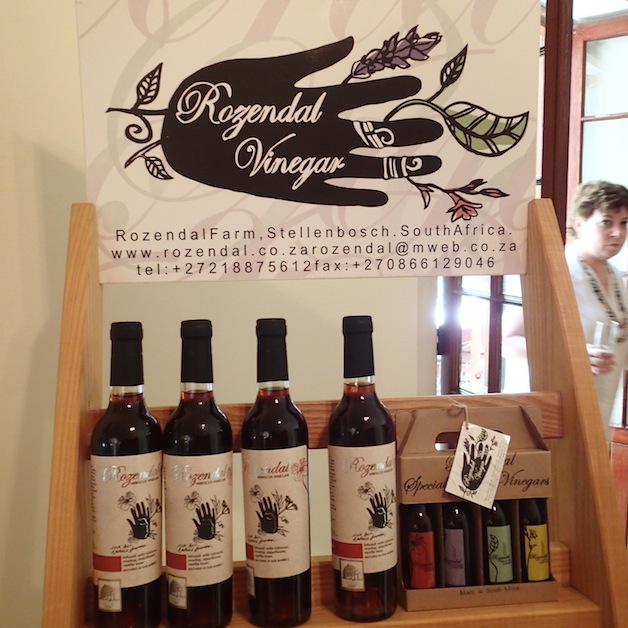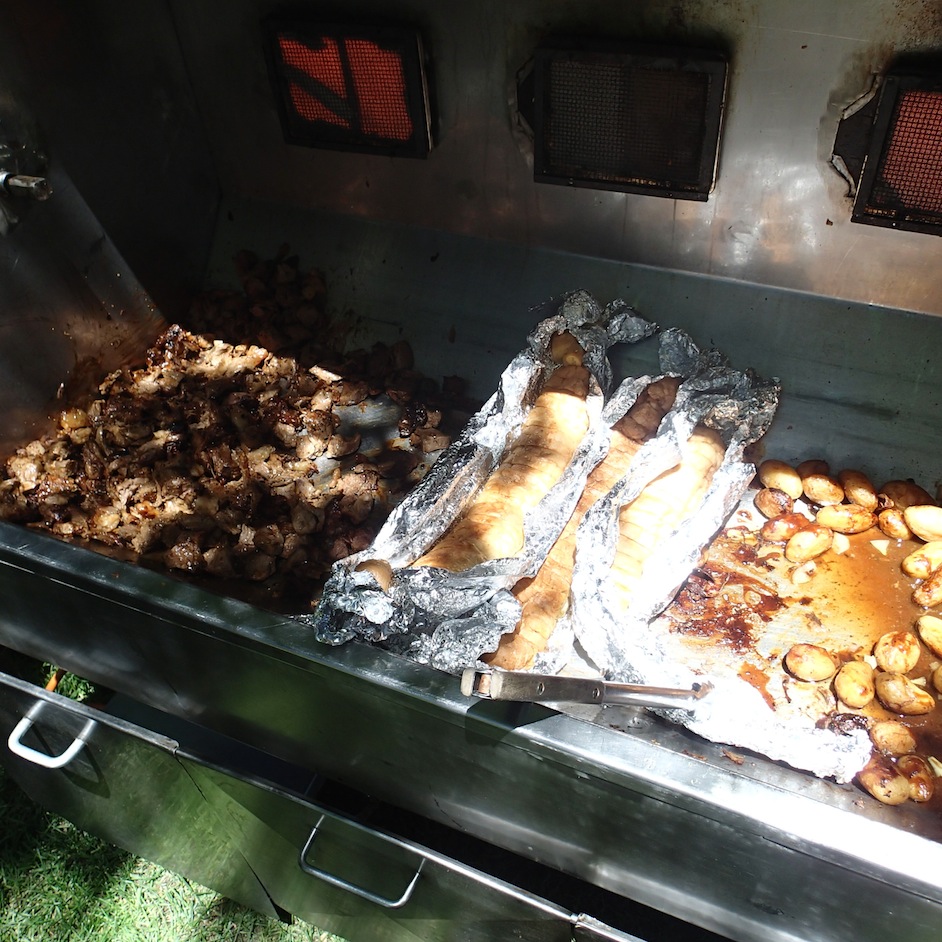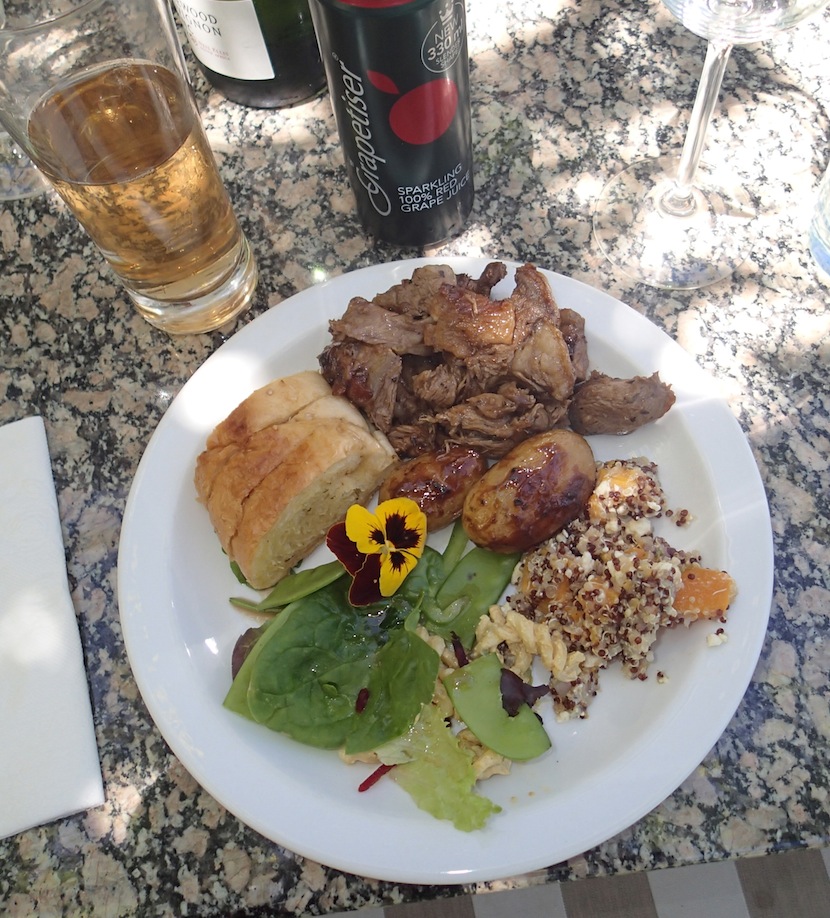I slipped out early, much to the dismay of my eager to please hosts at the lovely 19th century Malan’s Guest House in Stellenbosch, but I needed to see that Cape coast one more time before the business of what brought me to South Africa—working with biologists from around the world on the “wicked” problems of invasive species—took me away from the mad Atlantic spray and the flower flashed “fiynbos” (from “fine bush”) running up the mountainsides.
The Cape of Good Hope section of Table Mountain National Park is astounding in the early morning before any tour buses have ventured forth. I avoided the urge to point straight toward the huge cliffs that thunder down the Cape at the end of the Earth and instead veered off on a traverse over the low windswept plain of Olifantsbos to the Sirkelsvlei loop trail.
Only a couple of surfers and a pesky troop of baboons roamed the distal parking lot early on, and the wind hadn’t shown up yet, either. Above the first uphill section a baboon sits lordly on a sharp rock outcrop, pretending not to care that I’d disturbed his morning sun worship.
After stepping quietly around him, the trail then flattened and was at times paved in flat stones somewhere between limestone and marble, and at others packed with sand that nicely revealed the tracks of recent non-human trekkers.
It’s the kind of trail that constantly plays games—sometimes giving wide vistas, sometimes snaking through a maze of rock walls, the plump dassies scurrying away like Jawas, sometimes passing right under blocky rock arches. The one constant is flowers.
I came after a big rain a week or so previous, which may explain the flowers, but also turned the loop trail into an out and back. When I got to the Sirkelsvlei–which appeared as a welcome water hole on the Park map–after hopping the last 100 yards of sodden ground from rock to rock, the scrim of moisture I was expecting was more like an alpine lake. The next wooden stake trail marker was three feet deep and twenty feet out from shore, the water surface now corrugated by the recently freshened wind.
I hadn’t left time for the loop, anyhow, and so I returned, running back the trail past elands and ostriches. The cool morning was turning into a scorcher. On my return, I slipped around the parking lot baboons—them not nearly as disinterested as my distinguished friend on the trail—and into the kelp-strewn Atlantic. Within seconds, I was transported from hot to cool to frigid to out of the Atlantic.
I threw on some clothes and powered my ridiculous but sure-footed baby blue Fiat 500 through the curves of the M4 coastal road, giving plenty of room (when I could) to the hundreds of bicyclists who make this coast their Sunday morning outing, and (when I could not) slamming the brakes and grinding the gears (sorry Avis, I’ve just never shifted with my left hand before) until the next short straight stretch.
By 12:30pm, my heart still racing from racing a fast-looking Smart Car back inland, I was sitting under the shade of a large oak tree by a lazy stream in the genteel grounds of Auberge Rozendal in Stellenbosch with a bunch of ecologists. Some of them were uncharacteristically cajoling the various children they had brought along to this picnic to harass animals and give chase to a Hadeda ibis so that it might make its shockingly loud call for the benefit of an American visitor.
The oak and the ecologists and the auberge and the bird had all converged here to enjoy good food and (I had supposed) wine, though I was wondering why the wine wasn’t forthcoming.
I had only half read my invitation, so I assumed that since we were in Stellenbosch– the heart of South Africa’s wine country–the gathering would be at a winery, but Auberge Rozendal was not a winery really, but a vinegary, or whatever some such place that produces vinegars with all sorts of local flavors is known.
If one drinks wine at a winery then of course one drinks vinegar at a vinegary. A shot from the tap (two if you’re stout-hearted)—today’s flavor was hibiscus–with some water and some ice and it’s all quite lovely. Good thing too, as I would be highly unqualified to tell you anything about the wine, if we had had any.
I’m here as a marine biologist and writer who likes to deal with wicked problems, at the invitation of Dave Richardson, the director of Stellenbosch University’s Center for Excellence for Invasion Biology. The ecologists are here to celebrate another year of fighting the wickedly difficult fight against various invasive plant and animal species in the U.S., Canada, Europe, Chile, and here in Africa.
The bird is here because it itself is an invasive species—though not some horribly destructive crab or mussel that made its way here in a shipping container—but a South African bird which has only recently been rapidly expanding its range within its own country. The bird likes and needs the following: 1) sources of standing water; 2) big trees to roost in; and 3) soft ground to poke its bill into and pull up food.
The relatively recent transformation of Stellenbosch has provided all of the above. The increased agriculture has brought lots of water to the area and the increased wine tourism has brought lots of lovely soft lawns around big shady trees–with only the occasionally annoying child cajoled into wickedness by those who should know better—a haven as appealing for a Hadeda ibis as for a human.
Dave was the first local to record the arrival of the Hadeda, but farmers and birders all around the country have noted its arrival in new lands. It’s not hard—the loud screaming squawk that it produces unprovoked in the early morning is a dead giveaway to its presence—and it makes for a good lot of observations on how this creature is adapting to the new South African landscape.
Though while some things are new here, many things remain the same. Locals here, for example, wouldn’t dream of inviting foreign guests out for an afternoon get together without some braai.
Sometimes well-cooked food makes you say, “Damn”. “Damn, that looks good,” I said to the young braai master, “what is it?”. “We call it spitbraai,” he replied over the heat and sizzle of the meat, “we’ve got potatoes and garlic bread and lamb.” I thought it would be a good time to start learning some Afrikans. “Spitbraai, huh. What do you call the lamb, then?” I asked. “‘Lamb’ is ‘lamb’,” he replied. Pleased with my quick start in a new language, I filled my plate.
Hot lamb braii and a cool hibiscus vinegar cordial in the shade of an oak tree by a babbling brook amidst the once again silent ground poking of the Hadedas provides a satisfaction that can only be topped by one thing, and a yearning that can only be filled by that same thing.
I made my way back to the guest house, politely ignored my host’s passive aggressive admonishment for missing breakfast again (the day before, my jet-lag had counseled me aggressively against leaving the bed before noon), slipped into my room and not even taking a moment to let my eyes adjust to the 19th century darkness, fell into a delicious sleep.

